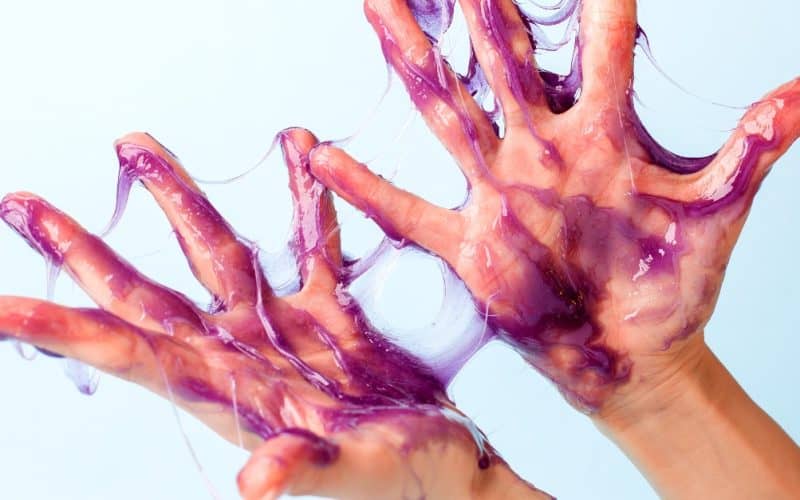Children are innately curious. They enter the world eager to learn, using all their senses to absorb information about everything around them.
Non-nutritive suckling is considered a normal part of fetal and newborn development. Putting things in their mouths is one way for babies and toddlers to learn about the world around them. According to Autism Speaks, this behavior typically fades away around 18 months.
However, some children continue to engage in this activity and take it further by ingesting non-nutritive, non-food items.
A common item children like to feed on is glue. But why do kids eat glue?
There are a variety of reasons why your child may engage in eating glue, ranging from innocent and harmless, to potential physical, developmental, or mental health issues.
Continue reading to find out why kids eat glue, the dangers, and some solutions below.
Why Do Kids Eat Glue?
-
Kids Are Naturally Curious

Children are naturally curious. They like to explore the world around them by getting their hands dirty and tasting everything they can get their hands on.
Using all their senses they learn about the world around them by experiencing it.
Glue is one of those amazing substances that children love to experience. Glue’s thick, gooey nature is ideal to play with. Additionally, some glue comes in a wide range of vibrant colors, and some even glow in the dark or have glitter.
Moreover, when the glue dries, its appearance and consistency change. Children notice this change and are mesmerized by it. When the glue dries on their hands or skin, it becomes a thin film they just have to examine further.
Whether wet or dry, glue is a material ripe for exploration and learning. Eating it, no matter its form may seem like a logical activity for a child learning about their environment.
-
They Need Attention
In some cases, children may not feel they are getting enough attention from the adults in their lives. When children feel neglected, whether because their parents are working, there’s a new child (or someone that requires care) at home, or too many children in a classroom, children may resort to less desirable behavior to get what they want or need.
When adults first notice a child eating glue, their first reaction might be big enough for the child to feel noticed. In their eyes, negative attention is better than no attention at all. As a result, the child will continue to eat glue to get the same response and subsequent attention from their grown-up.
-
They Defy to Learn Limits
As children become autonomous, they begin to discover their voice. When kids figure out they can make choices or express their wants, they begin testing the waters to see what and how much they can get away with.
One such way of testing their parents’ limits is by defying their instructions or requests. If your child notices you do not approve and don’t want them to eat something that could potentially be harmful to them, such as glue, they may do it to see your reaction and how much you allow them to get away with.
Acts of defiance allow children to figure out what they can get away with.
-
Hunger
Your child may seek to eat glue because they are hungry. If you notice your child eating glue before snack time or dinner, it may be a sign they are hungry.
Depending on your child’s temperament, they may be hungry and not realize it, they may not know how to ask, or they may be shy or weary about asking for a snack.
-
They May Suffer from Pica
According to the National Alliance for Eating Disorders, Pica can be described as a “feeding or eating disorder that involves eating non-nutritive, non-food substances.” These items can include:
- Dirt
- Clay
- Rocks or pebbles
- Paper or cardboard
- Hair
- Crayons
- Chalk
- Glue
- Paint (chips)
- Feces
- Plants or grass
- Plaster
- Large amounts of ice
- Cigarette butts
- Coins
- Small toys
Although doctors don’t know exactly what causes pica, it appears to be most common in individuals with developmental issues, such as autism, mental health problems, such as obsessive-compulsive disorder (OCD), nutrient deficiencies, hunger, or stress.
Dangers
For the most part, eating non-toxic glue, such as Elmer’s glue, may cause no major issues.
Keep in mind, however, that consuming large amounts of glue may lead to stomach pains, bowel problems or obstructions, and intestinal infections.
Consuming, even inhaling, industrial glues, such as superglue or anything stronger than school glue, may lead to serious health issues.
Do not hesitate to contact a poison control hotline or your pediatrician if your child ingests toxic glue.
While consuming small amounts of non-toxic glue may not be detrimental to your child’s health, if this behavior continues for a long period, it may be a good idea to contact your pediatrician to discuss the possible reasons why your kid may be eating glue.
How to Stop Your Child from Eating Glue
-
Give Your Child the Attention They Crave

Children constantly seek the love and approval of the adults in their lives, especially their parents or guardians. Often, they do so through silent cues.
Try to notice when your child does something they may be proud of, such as building the tallest block tower, sharing with their sibling, or following directions. Give genuine praise and recognition when they do something positive.
You if start to notice a decline in their glue consumption, express your delight in their change in behavior by praising them for building their willpower.
Don’t be overly enthusiastic, however, as this may cause the opposite effect and they may end up avoiding glue only when you are around to witness it.
Offer them a reward for not eating glue, or doing anything positive for that matter, by spending more time together. Join your child in doing something with them they enjoy.
Paying attention to them during the day when they do small or big things can go a long way in making them feel seen. This is especially important when going through any changes in their family structure or dynamics.
-
Switch to Less Alluring Glue
If your child is eating glue due to its attractive, colorful, glittery nature, a simple swap for less alluring glue may do the trick.
Switching to plain glue may look less like food and prove less tempting for your little one. Glue sticks may be another solution.
-
Change Up Craft-time
If your child just won’t stop eating glue, even after swapping for a less attractive-looking type, it may be time to shelve it for a while.
Crafting activities are important to your child’s development and creativity; therefore, it is important to continue such hobbies.
Instead of taking craft time away from your child because they won’t stop eating glue, switch to crafts where you can use tape. Or switch to glue-less crafts altogether.
There are many fun crafting activities you can do without the need for glue, such as pipe-cleaner art, origami, coloring, drawing, and painting.
-
Monitor Your Child Around Glue
Keep a close eye on your child when around glue. Try to notice when they consume it.
If you catch them in the act, gently tell them to stop and offer them a snack instead. Take advantage of the opportunity to talk to your child in a non-judgmental manner. You want to find out why your child is involved in this behavior, why they think they do it, and how it makes them feel.
Do your best to not get frustrated, or angry or make them feel ashamed or embarrassed for eating glue. This may cause them to internalize their feelings and think they are bad or gross for doing so. You do not want your child to incorporate those thoughts or feelings into their self-image.
Be gentle and let your child know you are genuinely curious about them and just want to know if there is anything they need or if you can help.
Additionally, communicate with their teacher or other caregivers and ask them if they have noticed your child consuming glue and if they have noticed any patterns associated with the behavior.
-
Find the Source of the Problem
If your child continues to eat glue after you’ve tried some of the simpler solutions, it may be time to contact your pediatrician, especially if your kid is over two years of age and they are experiencing stomach issues.
Determining the cause of the behavior will help you determine the best way to support your child.
Your pediatrician can help you rule out any nutritional deficiencies or developmental problems. And they may also refer you to a health professional to determine if a mental health issue may be the cause.
Final Thoughts
Children are naturally curious and adventurous. Watching them learn about their environment can fulfilling as well as concerning at times.
When children engage in behaviors that are out of the norm or that may be harmful to them, it can be unnerving for any parent.
While kids eating glue may be troubling, it is important to understand the causes and dangers to be able to help them better. The solution may be something as simple as giving them more attention or switching to less alluring glue, to something requiring professional help, such as a physical, mental, or developmental issue.
Asking, “why do kids eat glue?” is the first step in getting to the root of the problem.
